Related Research Articles
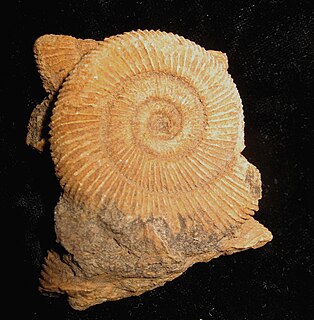
Dactylioceras was a widespread genus of ammonites from the Lower Jurassic period, approximately 180 million years ago (mya).
Zugodactylites is an extinct genus of ammonite cephalopod from the lower Toarcian epoch of the Lower Jurassic, ammonite zone Fibulatum. Its fossils are found in Europe, Russia and Canada.
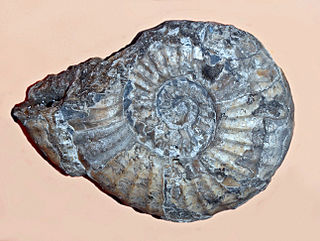
Psiloceratoidea is a superfamily of Early Jurassic ammonoid cephalopods proposed by Hyatt in 1867, assigned to the order Ammonitida. They were very successful during Hettangian and Sinemurian. Last of them, family Cymbitidae and genera Hypoxynoticeras and Radstockiceras survived into Early Pliensbachian.

Lytoceratidae is a taxonomic family of ammonoid cephalopods belonging to the suborder Lytoceratina, characterized by very evolute shells that generally enlarge rapidly, having whorls in contact but mostly overlapping very sightly, or not at all.

The family Dactylioceratidae comprises Early Jurassic ammonite genera with ribbed and commonly tuberculate shells that resembled later Middle Jurassic stephanoceratids and Upper Jurassic perisphinctids. Shells may be either evolute or involute.

Harpoceras is an extinct genus of cephalopod belonging to the family Hildoceratidae. These cephalopods existed in the Jurassic period, during Toarcian age from Falciferum zone to Commune subzone of Bifrons zone. They were fast-moving nektonic carnivores.

Harpoceratinae is an extinct subfamily of cephalopods belonging to the family Hildoceratidae. Ammonites of this subfamily had involute and compressed shells with strong keels. Keel might be rarely missing, but this is considered to be an abnormality. This has been observed both in Cleviceras and Harpoceras and called as genus Monestieria, which is now known to be invalid. Another example is Pseudolioceras, whose unkeeled specimen was used as type for description of invalid genus Praehaploceras. Oxyconic forms of this subfamily does not have any keel. Ribs were single, but in some genera also bifurcating with shapes from sigmoidal to falcate. Sometimes, shell can have only striate ribs or is smooth. Tubercules are rare. Dimorphism is known in some genera and it is observable mostly in size. Macrochons can be 4, to 6 times larger than microconchs. As an example, macroconchs of Pseudolioceras are more than 150mm in diameter, while adult microconchs are only 35-50mm. There are big size differences even within dimorphs. Specimens ca be 2, or sometimes even 3 times bigger than other specimens of same dimorph.
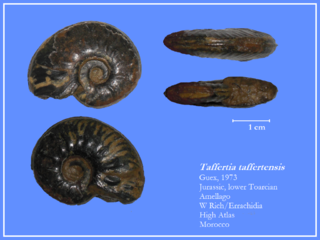
Taffertia is an extinct genus of cephalopod belonging to the family Hildoceratidae. These cephalopods existed in the Jurassic period, during Toarcian age in the Falciferum zone and possibly only in Exaratum subzone. Its fossils were found in Canada, Morocco, Algeria and Italy
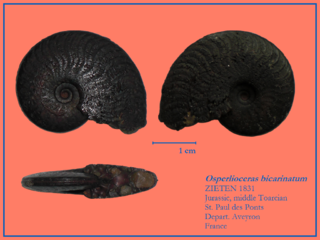
Osperleioceras is an extinct genus of cephalopod belonging to the family Hildoceratidae. These cephalopods existed in the Jurassic period, during Toarcian stage. Its fossils were found in Europe and South America. First species of this genus, Osperleioceras bicarinatum has evolved in what is now France from Harpoceras subplanatum.

Cleviceras is an extinct genus of cephalopod belonging to the family Hildoceratidae. These cephalopods existed in the Jurassic period, during Toarcian and possibly even uppermost Pliensbachian age. Sometimes, it is considered to be a synonym of Eleganticeras.
Radstockiceras is an extinct genus of lower Jurassic ammonite that lived from Oxynotum zone of upper Sinemurian to Raricostatum zone of lower Pliensbachian. Shells of these animals were oxycone and involute with umbilicus that took maximum of 12% of diameter in the case of outer whorls. On inner whorls, venter has been sharp, but then it became rounded. Faint ribs had falcoid shape, but sometimes, ribs could absent. Shells could have been large in their size. Suture has been very complex, similar to Oxynoticeras, but culmination at umbilical margin has been missing. Genus has been named after town of Radstock, in Somerset.

Prodactylioceras is genus of ammonite that lived during the Pliensbachian stage of early Jurassic. It has evolved from Reynesocoeloceras, but maybe not directly, but through Bettoniceras. Its fossils were found in Europe, Asia and North America.
Bettoniceras is genus of ammonite that lived during the Pliensbachian stage of the early Jurassic. It evolved from Reynesocoeloceras in Davoei ammonite zone and died out during Margaritatus zone. It is possible that Prodactylioceras evolved from this genus. Fossils of this genus have been found in Europe, Morocco, Tunisia, and Chile. Sometimes this genus is not considered valid, but just as a synonym of Prodactylioceras.
Reynesoceras is genus of ammonites that lived during the upper Pliensbachian stage of early Jurassic. It has evolved from Prodactylioceras, or Cetonoceras. Dactylioceras (Eodactylites) has probably evolved from this genus. Aveyroniceras is a name for macroconchs of this genus. Their fossils were found in Europe, northern Africa, Asia, North America and South America.
Nodicoeloceras is genus of ammonite that lived during early to middle Toarcian stage of early Jurassic. Members of this genus existed from Exaratum Subzone of Falciferum Zone to Commune subzone of Bifrons Zone. Their fossils were found in Europe, northern Africa, Asia, North America and South America. It has probably evolved from Dactylioceras (Orthodactylites) or Kedonoceras and gave rise to Mesodactylites.

The subfamily Dactylioceratinae comprises early Jurassic ammonite genera that lived during Upper Pliensbachian to Upper Toarcian stage. These dactylioceratids existed from Margaritatus ammonite Zone, when they have evolved from Reynesocoeloceratinae and died out in Variabilis Zone without leaving any descendants.
Neolioceratoides is genus of ammonites that lived during the Pliensbachian and Toarcian stages of early Jurassic. It has been considered to be a synonym of Lioceratoides, but cladistic analysis has shown, that this genus is not only valid, but they even belong to different subfamily, as Lioceratoides belongs to Harpoceratinae. Their fossils were found in Europe and northern Africa.
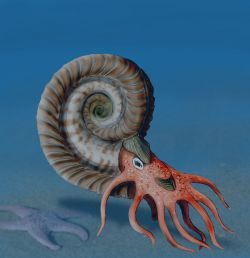
Hildoceratinae is an extinct subfamily of cephalopods belonging to the family Hildoceratidae. Ammonites of this subfamily had shells with elliptical or quadrate whorl section with keel or tricarinate, bisulcate venter. Ribs were variable, from falcate to strongly angled and from fine to strong. They can be interrupted by spiral groove in midlateral part of the shell. While some species can be smooth, strongly ribbed ones can have tubercules. Microconchs have short lapplets that is in its shape similar to the shape of growth lines in spiral midlateral groove.

Orthildaites is a genus of ammonites that lived during the lower Toarcian stage of early Jurassic, during Falciferum subzone.
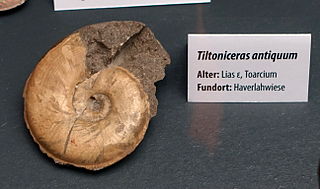
Tiltoniceras is an extinct genus of cephalopod belonging to the family Hildoceratidae. These cephalopods existed in the Jurassic period, from upper Pliensbachian age, Spinatum zone until lower Toarcian, Tenuicostatum zone in what is now Europe, North America and Asian part of Russia.
References
- 1 2 3 M. K. Howarth 2013. Treatise on Invertebrate Paleontology, Part L, Revised, Volume 3B, Chapter 4: Psiloceratoidea, Eoderoceratoidea, Hildoceratoidea.
- 1 2 3 4 5 WIEDENMAYER, Felix. Die Ammoniten Der Mediterranen Provinz Im Pliensbachian Und Unteren Toarcian Aufgrund Neuer Untersuchungen Im Generoso-Becken: Lombardische Alpen. Birkhauser, 1980.
- ↑ KOVÁCS, Z. (2011): Lower Toarcian Ammonitida fauna and biostratigraphy of the Gerecse Mountains (Hungary). — Fragmenta Palaeontologica Hungarica, 29: 1–48.
- 1 2 3 M. K. Howarth 1992. HILDOCERATIDAE IN THE LOWER JURASSIC OF BRITAIN